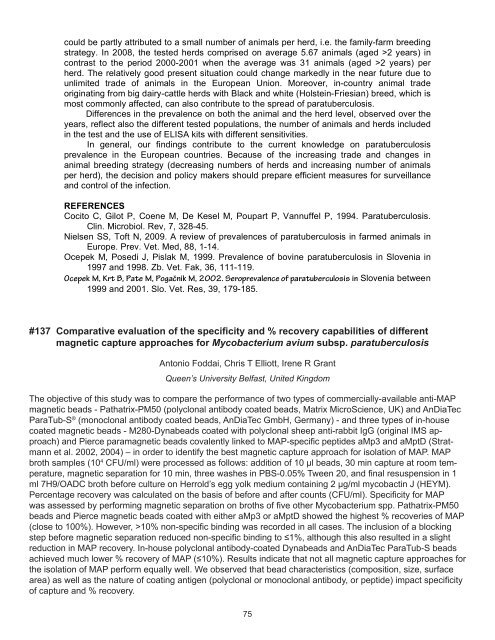Proceedings of the 10th International Colloquium on Paratuberculosis
Proceedings of the 10th International Colloquium on Paratuberculosis
Proceedings of the 10th International Colloquium on Paratuberculosis
Create successful ePaper yourself
Turn your PDF publications into a flip-book with our unique Google optimized e-Paper software.
could be partly attributed to a small number <str<strong>on</strong>g>of</str<strong>on</strong>g> animals per herd, i.e. <str<strong>on</strong>g>the</str<strong>on</strong>g> family-farm breeding<br />
strategy. In 2008, <str<strong>on</strong>g>the</str<strong>on</strong>g> tested herds comprised <strong>on</strong> average 5.67 animals (aged >2 years) in<br />
c<strong>on</strong>trast to <str<strong>on</strong>g>the</str<strong>on</strong>g> period 2000-2001 when <str<strong>on</strong>g>the</str<strong>on</strong>g> average was 31 animals (aged >2 years) per<br />
herd. The relatively good present situati<strong>on</strong> could change markedly in <str<strong>on</strong>g>the</str<strong>on</strong>g> near future due to<br />
unlimited trade <str<strong>on</strong>g>of</str<strong>on</strong>g> animals in <str<strong>on</strong>g>the</str<strong>on</strong>g> European Uni<strong>on</strong>. Moreover, in-country animal trade<br />
originating from big dairy-cattle herds with Black and white (Holstein-Friesian) breed, which is<br />
most comm<strong>on</strong>ly affected, can also c<strong>on</strong>tribute to <str<strong>on</strong>g>the</str<strong>on</strong>g> spread <str<strong>on</strong>g>of</str<strong>on</strong>g> paratuberculosis.<br />
Differences in <str<strong>on</strong>g>the</str<strong>on</strong>g> prevalence <strong>on</strong> both <str<strong>on</strong>g>the</str<strong>on</strong>g> animal and <str<strong>on</strong>g>the</str<strong>on</strong>g> herd level, observed over <str<strong>on</strong>g>the</str<strong>on</strong>g><br />
years, reflect also <str<strong>on</strong>g>the</str<strong>on</strong>g> different tested populati<strong>on</strong>s, <str<strong>on</strong>g>the</str<strong>on</strong>g> number <str<strong>on</strong>g>of</str<strong>on</strong>g> animals and herds included<br />
in <str<strong>on</strong>g>the</str<strong>on</strong>g> test and <str<strong>on</strong>g>the</str<strong>on</strong>g> use <str<strong>on</strong>g>of</str<strong>on</strong>g> ELISA kits with different sensitivities.<br />
In general, our findings c<strong>on</strong>tribute to <str<strong>on</strong>g>the</str<strong>on</strong>g> current knowledge <strong>on</strong> paratuberculosis<br />
prevalence in <str<strong>on</strong>g>the</str<strong>on</strong>g> European countries. Because <str<strong>on</strong>g>of</str<strong>on</strong>g> <str<strong>on</strong>g>the</str<strong>on</strong>g> increasing trade and changes in<br />
animal breeding strategy (decreasing numbers <str<strong>on</strong>g>of</str<strong>on</strong>g> herds and increasing number <str<strong>on</strong>g>of</str<strong>on</strong>g> animals<br />
per herd), <str<strong>on</strong>g>the</str<strong>on</strong>g> decisi<strong>on</strong> and policy makers should prepare efficient measures for surveillance<br />
and c<strong>on</strong>trol <str<strong>on</strong>g>of</str<strong>on</strong>g> <str<strong>on</strong>g>the</str<strong>on</strong>g> infecti<strong>on</strong>.<br />
REFERENCES<br />
Cocito C, Gilot P, Coene M, De Kesel M, Poupart P, Vannuffel P, 1994. <strong>Paratuberculosis</strong>.<br />
Clin. Microbiol. Rev, 7, 328-45.<br />
Nielsen SS, T<str<strong>on</strong>g>of</str<strong>on</strong>g>t N, 2009. A review <str<strong>on</strong>g>of</str<strong>on</strong>g> prevalences <str<strong>on</strong>g>of</str<strong>on</strong>g> paratuberculosis in farmed animals in<br />
Europe. Prev. Vet. Med, 88, 1-14.<br />
Ocepek M, Posedi J, Pislak M, 1999. Prevalence <str<strong>on</strong>g>of</str<strong>on</strong>g> bovine paratuberculosis in Slovenia in<br />
1997 and 1998. Zb. Vet. Fak, 36, 111-119.<br />
Ocepek M, Krt B, Pate M, Pogačnik M, 2002. Seroprevalence <str<strong>on</strong>g>of</str<strong>on</strong>g> paratuberculosis in Slovenia between<br />
1999 and 2001. Slo. Vet. Res, 39, 179-185.<br />
#137 Comparative evaluati<strong>on</strong> <str<strong>on</strong>g>of</str<strong>on</strong>g> <str<strong>on</strong>g>the</str<strong>on</strong>g> specificity and % recovery capabilities <str<strong>on</strong>g>of</str<strong>on</strong>g> different<br />
magnetic capture approaches for Mycobacterium avium subsp. paratuberculosis<br />
Ant<strong>on</strong>io Foddai, Chris T Elliott, Irene R Grant<br />
Queen’s University Belfast, United Kingdom<br />
The objective <str<strong>on</strong>g>of</str<strong>on</strong>g> this study was to compare <str<strong>on</strong>g>the</str<strong>on</strong>g> performance <str<strong>on</strong>g>of</str<strong>on</strong>g> two types <str<strong>on</strong>g>of</str<strong>on</strong>g> commercially-available anti-MAP<br />
magnetic beads - Pathatrix-PM50 (polycl<strong>on</strong>al antibody coated beads, Matrix MicroScience, UK) and AnDiaTec<br />
ParaTub-S ® (m<strong>on</strong>ocl<strong>on</strong>al antibody coated beads, AnDiaTec GmbH, Germany) - and three types <str<strong>on</strong>g>of</str<strong>on</strong>g> in-house<br />
coated magnetic beads - M280-Dynabeads coated with polycl<strong>on</strong>al sheep anti-rabbit IgG (original IMS approach)<br />
and Pierce paramagnetic beads covalently linked to MAP-specific peptides aMp3 and aMptD (Stratmann<br />
et al. 2002, 2004) – in order to identify <str<strong>on</strong>g>the</str<strong>on</strong>g> best magnetic capture approach for isolati<strong>on</strong> <str<strong>on</strong>g>of</str<strong>on</strong>g> MAP. MAP<br />
broth samples (10 4 CFU/ml) were processed as follows: additi<strong>on</strong> <str<strong>on</strong>g>of</str<strong>on</strong>g> 10 µl beads, 30 min capture at room temperature,<br />
magnetic separati<strong>on</strong> for 10 min, three washes in PBS-0.05% Tween 20, and final resuspensi<strong>on</strong> in 1<br />
ml 7H9/OADC broth before culture <strong>on</strong> Herrold’s egg yolk medium c<strong>on</strong>taining 2 µg/ml mycobactin J (HEYM).<br />
Percentage recovery was calculated <strong>on</strong> <str<strong>on</strong>g>the</str<strong>on</strong>g> basis <str<strong>on</strong>g>of</str<strong>on</strong>g> before and after counts (CFU/ml). Specificity for MAP<br />
was assessed by performing magnetic separati<strong>on</strong> <strong>on</strong> broths <str<strong>on</strong>g>of</str<strong>on</strong>g> five o<str<strong>on</strong>g>the</str<strong>on</strong>g>r Mycobacterium spp. Pathatrix-PM50<br />
beads and Pierce magnetic beads coated with ei<str<strong>on</strong>g>the</str<strong>on</strong>g>r aMp3 or aMptD showed <str<strong>on</strong>g>the</str<strong>on</strong>g> highest % recoveries <str<strong>on</strong>g>of</str<strong>on</strong>g> MAP<br />
(close to 100%). However, >10% n<strong>on</strong>-specific binding was recorded in all cases. The inclusi<strong>on</strong> <str<strong>on</strong>g>of</str<strong>on</strong>g> a blocking<br />
step before magnetic separati<strong>on</strong> reduced n<strong>on</strong>-specific binding to ≤1%, although this also resulted in a slight<br />
reducti<strong>on</strong> in MAP recovery. In-house polycl<strong>on</strong>al antibody-coated Dynabeads and AnDiaTec ParaTub-S beads<br />
achieved much lower % recovery <str<strong>on</strong>g>of</str<strong>on</strong>g> MAP (≤10%). Results indicate that not all magnetic capture approaches for<br />
<str<strong>on</strong>g>the</str<strong>on</strong>g> isolati<strong>on</strong> <str<strong>on</strong>g>of</str<strong>on</strong>g> MAP perform equally well. We observed that bead characteristics (compositi<strong>on</strong>, size, surface<br />
area) as well as <str<strong>on</strong>g>the</str<strong>on</strong>g> nature <str<strong>on</strong>g>of</str<strong>on</strong>g> coating antigen (polycl<strong>on</strong>al or m<strong>on</strong>ocl<strong>on</strong>al antibody, or peptide) impact specificity<br />
<str<strong>on</strong>g>of</str<strong>on</strong>g> capture and % recovery.<br />
75






